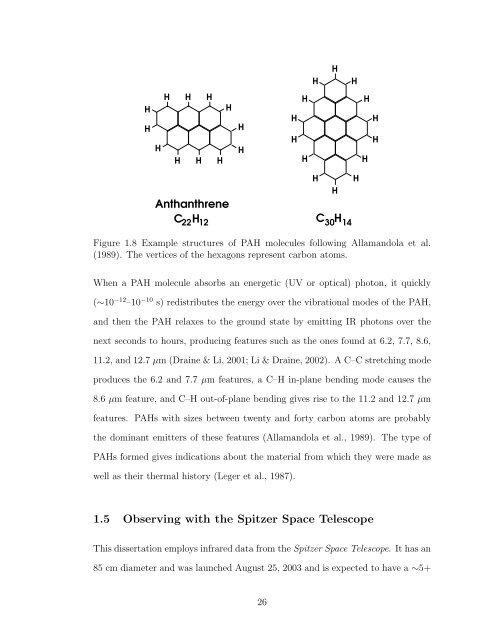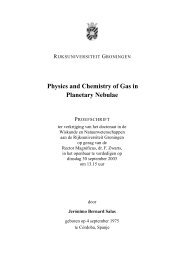TRACING ABUNDANCES IN GALAXIES WITH THE SPITZER ...
TRACING ABUNDANCES IN GALAXIES WITH THE SPITZER ...
TRACING ABUNDANCES IN GALAXIES WITH THE SPITZER ...
Create successful ePaper yourself
Turn your PDF publications into a flip-book with our unique Google optimized e-Paper software.
H<br />
H<br />
H<br />
H<br />
H<br />
H<br />
H H H<br />
Anthanthrene<br />
C H<br />
22 12<br />
H<br />
H<br />
H<br />
H<br />
H<br />
H<br />
H<br />
H<br />
H H<br />
H<br />
H<br />
C H<br />
30 14<br />
Figure 1.8 Example structures of PAH molecules following Allamandola et al.<br />
(1989). The vertices of the hexagons represent carbon atoms.<br />
When a PAH molecule absorbs an energetic (UV or optical) photon, it quickly<br />
(∼10 −12 –10 −10 s) redistributes the energy over the vibrational modes of the PAH,<br />
and then the PAH relaxes to the ground state by emitting IR photons over the<br />
next seconds to hours, producing features such as the ones found at 6.2, 7.7, 8.6,<br />
11.2, and 12.7 µm (Draine & Li, 2001; Li & Draine, 2002). A C–C stretching mode<br />
produces the 6.2 and 7.7 µm features, a C–H in-plane bending mode causes the<br />
8.6 µm feature, and C–H out-of-plane bending gives rise to the 11.2 and 12.7 µm<br />
features. PAHs with sizes between twenty and forty carbon atoms are probably<br />
the dominant emitters of these features (Allamandola et al., 1989). The type of<br />
PAHs formed gives indications about the material from which they were made as<br />
well as their thermal history (Leger et al., 1987).<br />
1.5 Observing with the Spitzer Space Telescope<br />
This dissertation employs infrared data from the Spitzer Space Telescope. It has an<br />
85 cm diameter and was launched August 25, 2003 and is expected to have a ∼5+<br />
26<br />
H<br />
H<br />
H<br />
H<br />
H













